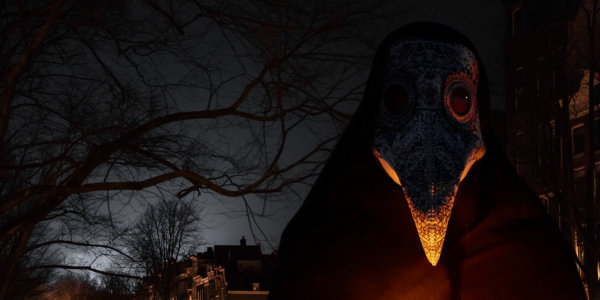Defoe is deeply troubled by the authorities’ decision to isolate whole families with at least one infected member within their own homes, a course of action that undoubtedly eventually causes the deaths of all the rest, unless they managed to escape by another exit. Each ‘condemned’ house was marked with a red cross to warn away those as yet uninfected, and a ‘watchman’ was posted outside the house to prevent escape by any of the inmates, but houses have back doors, as Defoe points out, and there were never enough watchmen to prevent the spread of the Plague. He himself offers the suggestion that the “sound” should be removed from the “sick” in a house of infection, but notes that it is not always possible to determine who is infected, as those in the early stages of infection may be asymptomatic. The same is true today. Defoe’s Journal records the distressing sight of a man, unbalanced by the sickness, running down the street naked, shrieking with pain.
Ever the conscientious journalist, Defoe keeps a regular tally of the increasing numbers of victims of the Plague, just as the Internet’s Worldometer today, with the benefit of instant communication throughout the world, keeps count of the number of cases reported in each country daily, as well as the mounting death toll, now at nearly half a million, around the globe. In a period of 20 days, Defoe reports, some 5,000 victims succumbed to the Plague in London. At another point, he claims more than 3,000 died in a single night. Quarantine had to be kept for suspected cases for a minimum of 60 days.
At one point in his narrative, Defoe deals with rumours of “a seeming propensity or a wicked inclination in those that were infected to infect others.” If this happened, it may, Defoe speculates, have been due to a “malignity” in “the very nature of man,” a “corruption of human nature who cannot bear to see itself more miserable than others of its own species,” or perhaps, more simply, it was brought on by “desperation,” but Defoe offers this explanation: “ I say that the thing is not really so, but that it was a general complaint raised by the people inhabiting the outlying villages against [London] citizens” to justify, or at least excuse, their own hardships.
For believers today, during the current crisis, places of worship have remained closed for months. This was not the case in the London of 1665. Defoe was, like most people of his time and place, a believer himself. He notes that the Plague has made everyone more aware of their vulnerability as human beings, and ventures thoughts on the benefits of faith, given the quarrelsome nature of humanity at its least engaging. A continuation of the Plague, he believes, would make us all better people:
I hope it will not be amiss to take notice of it that a near view of death would soon reconcile men of good principles one to another, and that is chiefly owing to our easy situation in life and our putting these things far from us that our breaches are fomented, ill blood continued, prejudices, breach of charity and of Christian union, so much kept and so far carried on among us as it is….
The Great Plague of 1665 was followed the next year by the Great Fire of London, during which Defoe notes, fire was seen to retard the spread of the Plague. He ends his account of the Plague with the following “coarse but sincere stanza of my own”:
A dreadful plague in London was
In the year sixty-five,
Which swept an hundred thousand souls
Away: yet I alive!





